Census 2011 equality results: analysis, part two
Publication bringing together relevant statistics from the census and other sources to paint a detailed picture of equality in Scotland.
Chapter 3: Religion
Introduction
This chapter presents an analysis of religion in the 2011 Census. It is intended as an overview and does not represent a definitive analysis of religion in Scotland. Comparisons have been made to highlight differences both between and within the different religions.
There are many other important inter-relationships between religion and other variables that could not be examined; either due to limitations of Census data or time constraints. In addition, the report does not try to provide commentary on the causes and background to the differences illustrated. The intention is that the report should stimulate discussion by highlighting interesting differences between people of different religions.
Summary of Religion Findings
- Those with 'no religion' were most likely to be economically active;
- Sikhs were most likely to be self-employed and be 'Managers, Directors and Senior Officials';
- Hindus were most likely to be employed in the top two occupational groups;
- Jewish people were most likely to be employed in the top three occupational groups, though this proportion fell over the decade;
- People who identified as 'Roman Catholic', 'Church of Scotland' and 'No religion' were least likely to be in the top three occupational groups;
- Buddhists were most likely to be in 'Elementary Occupations';
- The majority of 'Managers, Directors and Senior Officials' were male and the gender split was greatest for Muslims;
- Muslims and Sikhs were most likely to be employed in the 'Distribution, Hotels and Restaurants' industry;
- Hindu and Jewish people were most likely to be in the highest social grades and had the most representation in the highest two occupational categories;
- Hindus were most likely to work more than 37 hours per week;
- Hindus had the highest qualifications and were most likely to be full-time students. Those who recorded as 'Roman Catholic' and 'Church of Scotland' had the lowest qualifications and, along with 'No religion', were least likely to be students;
- Those identifying as 'Church of Scotland' and 'Sikh' were most likely to own their own home and they tended to live in houses. Hindus were the least likely to own their home and tended to live in flats;
- Home ownership increased over the decade for those who recorded as 'Church of Scotland' but fell for almost every other religion;
- Roman Catholics were most likely to live in social rented accommodation;
- Hindus who rented their accommodation were most likely to rent privately and those who identified as 'Church of Scotland' or 'Roman Catholic' were most likely to live in social rented accommodation;
- Overcrowding was highest for Muslims and lowest for those who identified as 'Church of Scotland';
- Sikhs had the most access to cars and Hindus had the least;
Background
In order to inform the development and monitoring of anti-discrimination policies, Scottish Ministers and the Parliament decided, after much consultation, that questions on religion should be included for the first time in the 2001 Census of Scotland, although on a voluntary basis. There was a question on current religion and one on religion of upbringing. A religion question was also included in the 2001 Census for England and Wales, with the primary purpose to collect more detailed information about particular minority ethnic groups. The situation in Scotland was slightly different as ethnic minorities made up a much smaller proportion of the population; thus, the focus was to obtain more reliable data to identify differences within Scottish society associated with the main religious denominations - Church of Scotland and Roman Catholicism.
In the 2011 Census, everyone in Scotland was asked a voluntary question on religion: 'What religion, religious denomination or body do you belong to?' The same question was asked in Scotland in 2001 and therefore direct comparisons can be made with Scotland a decade ago. The question on religion of upbringing, however, was not asked in 2011. And the question asked in Scotland was a different question to the one asked in England and Wales [52] . While the question in Northern Ireland had the same wording as the one asked in Scotland, it had a different set of response categories. Therefore the results are not directly comparable across the UK nations.
The following table sets out the number of responses to the religion categories in 2011 to allow the subsequent analysis to be put into context:
Table 3.1: Religion in Scotland, 2011
| 2011 |
||
|---|---|---|
| Number |
Percentage |
|
| All people |
5,295 |
100.0 |
| No religion |
1,941 |
36.7 |
| Church of Scotland |
1,718 |
32.4 |
| Roman Catholic |
841 |
15.9 |
| Religion not stated |
368 |
7.0 |
| Other Christian |
291 |
5.5 |
| Muslim |
77 |
1.4 |
| Hindu |
16 |
0.3 |
| Other religion |
15 |
0.3 |
| Buddhist |
13 |
0.2 |
| Sikh |
9 |
0.2 |
| Jewish |
6 |
0.1 |
List of Sub-chapters
Key Findings:
- Those with 'No religion' were most likely to be economically active;
- Sikhs were most likely to be self-employed and to be 'Managers, Directors and Senior Officials';
- Hindus were most likely to be employed in the top two occupational groups;
- Jewish people were most likely to be employed in the top three occupational groups, though this proportion fell over the decade;
- People who identified as 'Roman Catholic', 'Church of Scotland' and 'No religion' were least likely to be in the top three occupational groups;
- Buddhists were most likely to be in Elementary Occupations;
- The majority of 'Managers, Directors and Senior Officials' were male, and this proportion was highest for Muslims;
- Muslims and Sikhs were most likely to be employed in the 'Distribution, Hotels and Restaurants' industry;
- Hindu and Jewish people were most likely to be in the highest social grades and also the most likely to be in the highest two occupational categories;
- Hindus were the most likely to work more than 37 hours per week.
The Census and the Annual Population Survey ( APS) [53] are the two main sources of data on how different religion groups fare in the labour market. The APS data is released quarterly and is more up-to-date, whereas the Census data provides a more detailed breakdown of the ethnicity categories and is available at lower geographies.
It should be noted that there are a number of differences in the results from the 2011 Census and the APS. These are explained further in Annex A.
The charts in this chapter present the more detailed results from the Census.
Chart 3.1: Religion by Economic Activity - people aged 16+, Scotland 2011
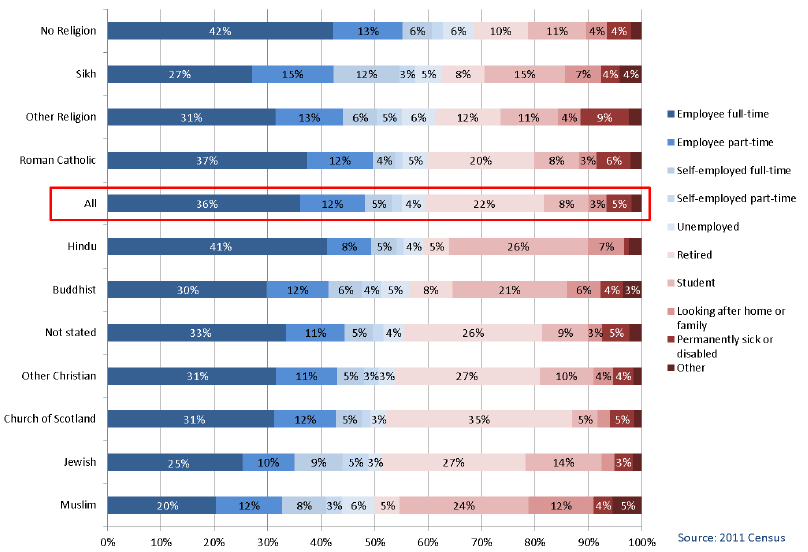
Economic activity relates to whether or not a person aged 16 and over was working or looking for work in the week before the census. Rather than a simple indicator of whether or not someone was currently in employment, it provides a measure of whether or not a person was an active participant in the labour market.
Chart 3.1 shows that those who reported 'No religion' were the most likely to be economically active [54] (69 per cent), and also to be working full-time as an employee (42 per cent).
The 'Sikh' group reported the highest proportion of self-employed people (15 per cent).
Around a quarter of Hindus, Muslims and Buddhists were students. It should be noted that these groups tended to have younger age profiles.
Those who reported that they were 'Church of Scotland' were most likely to be retired (35 per cent). This compared to just over a fifth (22 per cent) of the population as a whole.
The proportion of people aged 16 and over who were unemployed ranged from 3 per cent ('Jewish') to 6 per cent ('Other Religion').
Chart 3.2: Religion by Occupational Group - all people aged 16-74 in Employment, Scotland 2011
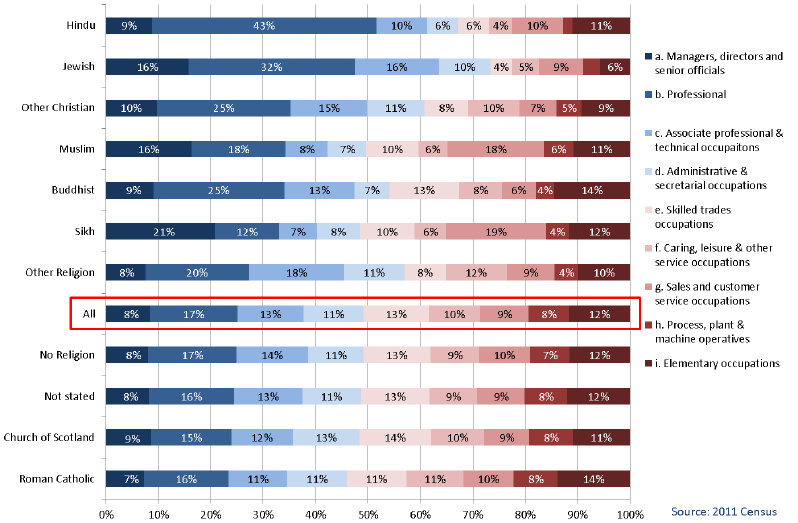
A person's occupation relates to their main job and is derived from either their job title or details of the activities involved in their job. [55]
Chart 3.2 shows that, for people aged 16-74 in employment, a relatively high proportion of people from religions outside of the Christian categories were 'Managers, Directors and Senior Officials' and 'Professionals'. Over half (52 per cent) of Hindus were in these occupational groups compared to less than a quarter (23 per cent) of Roman Catholics.
Those who identified as 'Sikh', the group most likely to be self-employed, were also the most likely to be 'Managers, Directors and Senior Officials' (21 per cent). A relatively high proportion of Sikhs were also in 'Sales and Customer Service occupations' (19 per cent).
Those who reported they were 'Church of Scotland' were the most likely to be in 'Skilled Trades Occupations' (14 per cent).
Those who identified as 'Roman Catholic' and 'Buddhist' were the most likely to be in 'Elementary Occupations' (14 per cent).
Chart 3.3: Religion by Occupational Group - all people aged 16-74 in employment who were in the top 3 Occupational Groups, Scotland 2001 and 2011 [56]
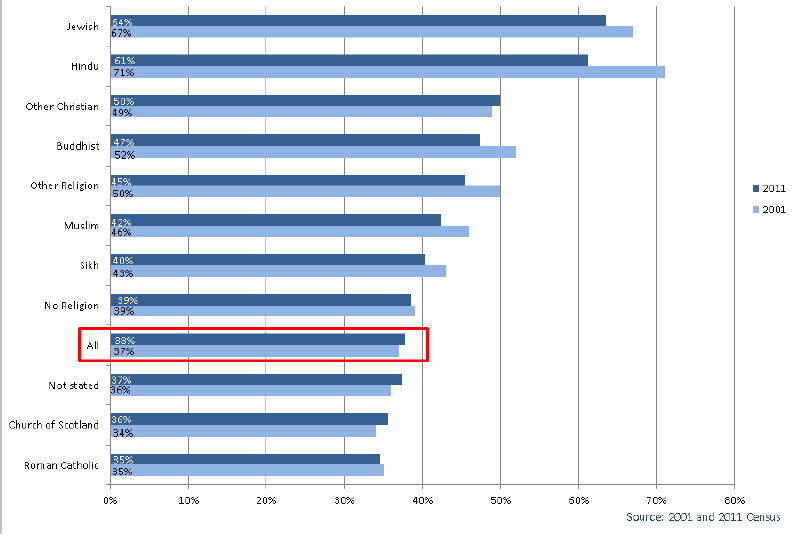
Chart 3.3 shows that almost two fifths (38 per cent) of people aged 16-74 in employment were in the top three occupational groups - this was up slightly from 37 per cent in 2001.
In 2011, those who recorded their religion as 'Jewish' were most likely to be in the highest occupational groups (64 per cent), though this was a fall of three percentage points over the decade.
In 2011 those who identified as 'Roman Catholic' were the least likely to be in the top three occupational groups (35 per cent), just below 'Church of Scotland' (36 per cent) which represented a two percentage point increase over the decade.
Chart 3.4: Religion by Occupational Group - all people aged 16-74 in Employment who were in Elementary Occupations, Scotland 2001 and 2011
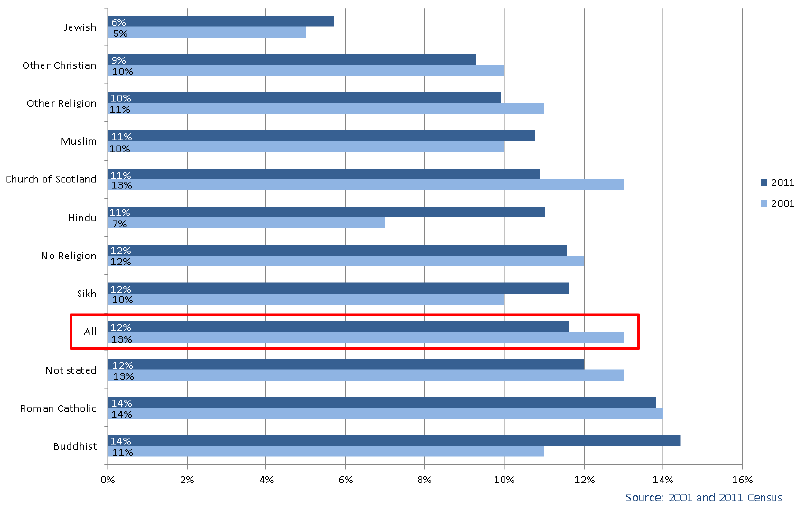
Chart 3.4 shows that in 2011 around an eighth (12 per cent) of people were in 'Elementary Occupations' and this was down slightly over the decade.
Those who identified as 'Roman Catholic' and 'Buddhist' were the most likely to be employed in 'Elementary occupations', with the latter group seeing a three percentage point increase over the decade
Only 6 per cent of those who identified as 'Jewish' were in 'Elementary occupations'.
Chart 3.5: Religion by gender - for Managers, Directors and Senior Officials aged 16-74 years in employment, Scotland 2011
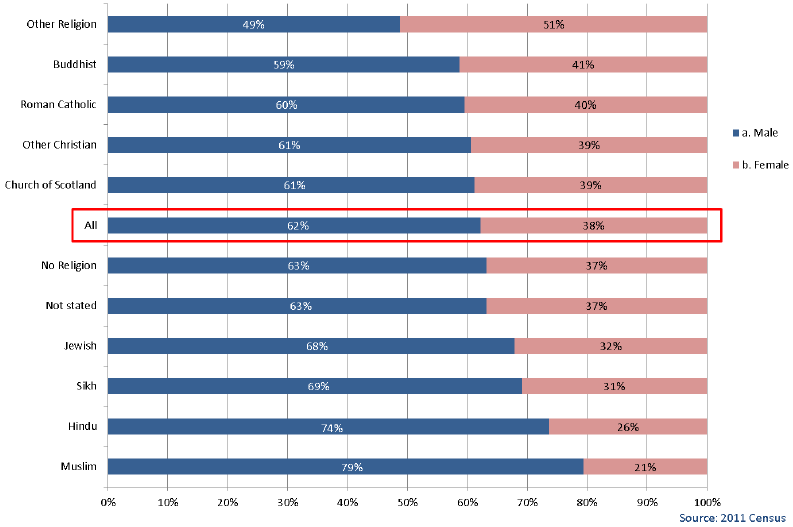
Chart 3.5 shows that the majority (62 per cent) of 'Managers, Directors and Senior Officials' were male, and males comprised the majority for all categories except 'Other Religion'.
This gender split was most pronounced for the 'Hindu' and 'Muslim' groups, at more than 70:30 male to female.
A gender split is available for the other occupational groups in the accompanying excel tables.
Chart 3.6: Religion by Industry - people aged 16-74 in employment, Scotland 2011 [57]
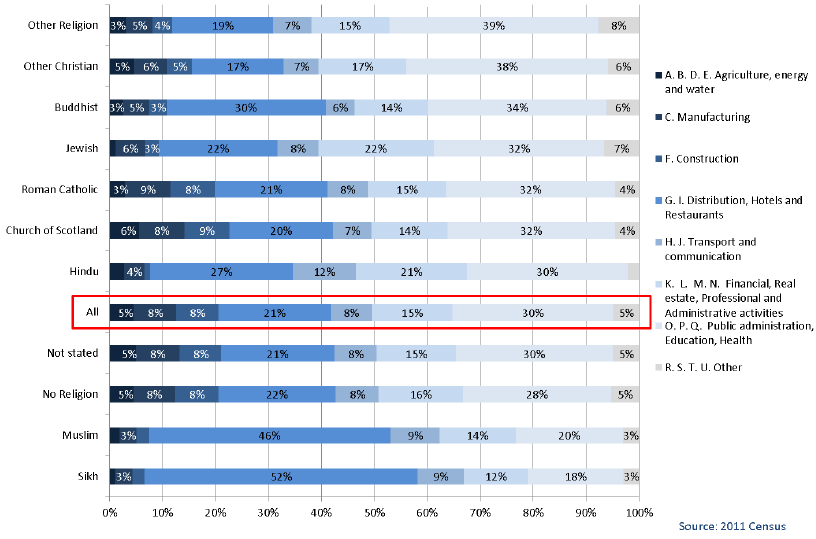
Chart 3.6 shows that 'Public Administration, Education, Health' was the industry sector accounting for the largest number of people aged 16-74 in employment (30 per cent). This proportion varied across the religion groups, ranging from less than a fifth (18 per cent) of Sikhs to almost two fifths (39 per cent) of those who recorded 'Other Religion'.
The next largest industry sector was 'Distribution, Hotels and Restaurants' where one fifth (21 per cent) of people were employed. Those who identified as 'Muslim' and 'Sikh' were well represented in this industry (46 and 52 per cent respectively).
Those who identified as 'Church of Scotland' reported relatively high proportions in the 'Agriculture Energy and Water', 'Manufacturing' and 'Construction' sectors - almost a quarter of this group worked in these industries.
Chart 3.7: Religion by NS-SeC - people aged 16-74, Scotland 2011
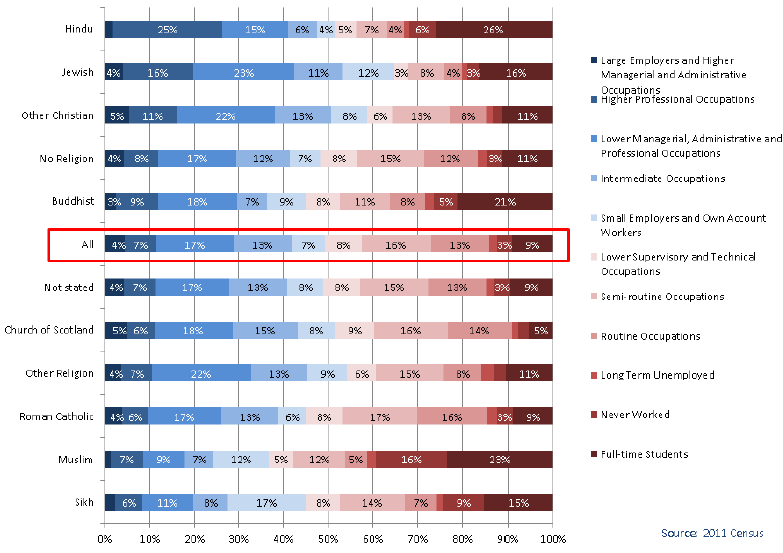
The National Statistics Socio-economic Classification ( NS-SeC) provides an indication of socio-economic position based on occupation. It is an Office for National Statistics ( ONS) standard classification. [58]
Chart 3.7 shows that those who recorded their religion as 'No religion' had slightly more representation in the highest two occupational NS-SeC groups than the 'Roman Catholic' and 'Church of Scotland' groups.
The 'Hindu' and 'Jewish' groups had the most representation in the highest two occupational categories (26 and 20 per cent respectively).
Only 15 per cent of the 'Jewish' group worked in 'Lower Supervisory and Technical Occupations', 'Semi-routine Occupations' and 'Routine Occupations' compared to 37 per cent of the population as a whole.
Almost a quarter (23 per cent) of the 'Muslim' group were full-time students, and a further 16 per cent had never worked.
Chart 3.8: Religion by hours worked - people aged 16-74 in employment, Scotland 2011
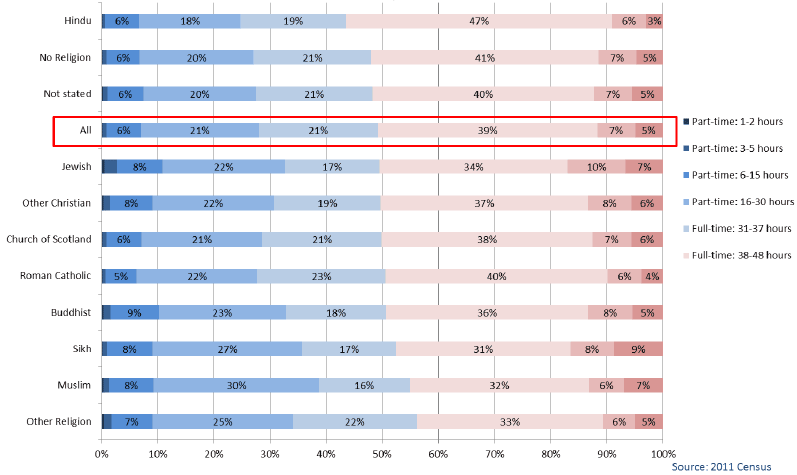
Chart 3.8 shows that the majority (60 per cent) of people in employment worked between 31 and 48 hours per week. Those who recorded 'No religion' worked longer hours on average than those who recorded as 'Church of Scotland' and 'Roman Catholic'.
Those who identified as 'Hindu' were most likely to work longer hours of 38 hours or more per week (56 per cent). Those who reported their religion as 'Jewish' were the most likely to work 49 hours or more (17 per cent) and Sikhs were the most likely to work very long hours of 60 hours or more (9 per cent) per week.
Chart 3.9: Religion by Social Grade - all people in households aged 16-64, Scotland 2011
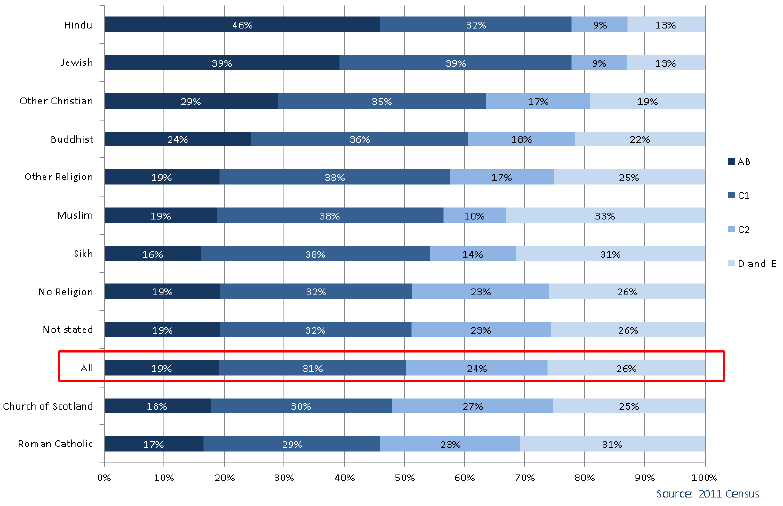
Social grade is the socio-economic classification [59] used by the Market Research and Marketing Industries, most often in the analysis of spending habits and consumer attitudes. Although it is not possible to allocate social grades precisely from information collected in the 2011 Census, the Market Research Society has developed a method for using Census information to provide a good approximation of social grade.
Chart 3.9 shows that half of people aged 16-64 were in the highest social grades, 'AB' and 'C1'. The only religions where a minority were in these grades were 'Roman Catholic' and 'Church of Scotland' (48 per cent and 46 per cent, respectively). All other religion categories showed higher than average proportions with almost four in five Hindu and Jewish people in these social grades. Almost half (46 per cent) of Hindus were in the highest social grade, ' AB'.
Chart 3.10: Religion by gender - all people in households aged 16-64 who were Social Grade AB, Scotland 2011
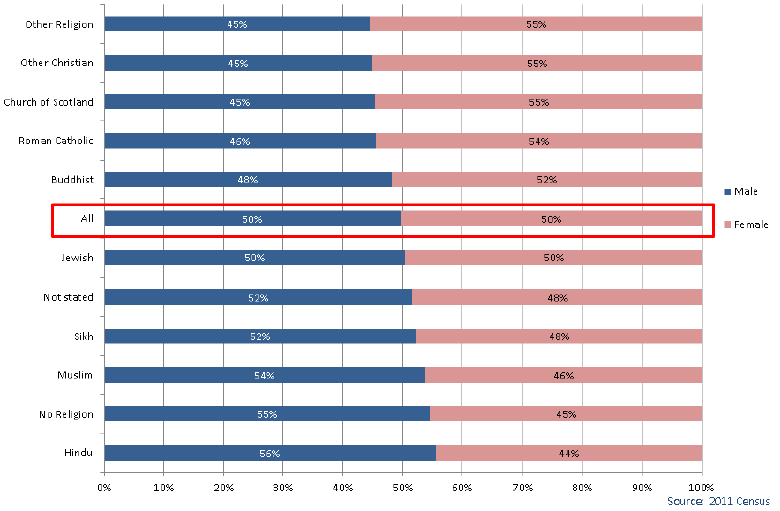
Chart 3.10 shows that there was an even gender split for those in the highest social grade, ' AB'. However this varied by religion - the majority (55 per cent) of those who recorded as 'Church of Scotland' in the ' AB' group were female. The opposite was true for Hindus, of whom the majority (56 per cent) were male.
Key Findings:
- Hindus had the highest qualifications and were most likely to be full-time students;
- Those who recorded their religion as 'Roman Catholic' or 'Church of Scotland' had the lowest qualifications and, along with 'No religion' were least likely to be full-time students.
Chart 3.11: Full-time students as a Proportion of those aged 16-24 by Religion, Scotland 2011
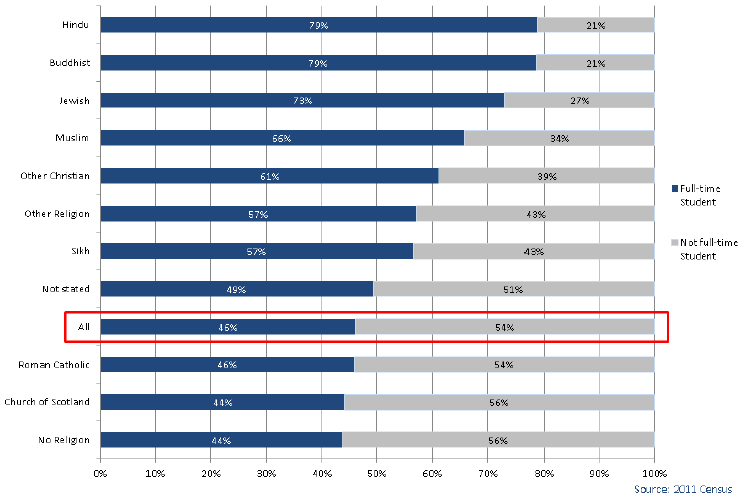
Chart 3.11 shows that almost half (46 per cent) of people aged 16-24 were full-time students. This proportion was slightly lower for those in the 'Roman Catholic', 'Church of Scotland' and 'No religion' groups, whereas every other religion category recorded higher proportions. Almost 80 per cent of Hindus and Buddhists in the 16-24 age group were full-time students.
Chart 3.12: Religion by Highest Qualification - all people aged 16+, Scotland 2011 [60]
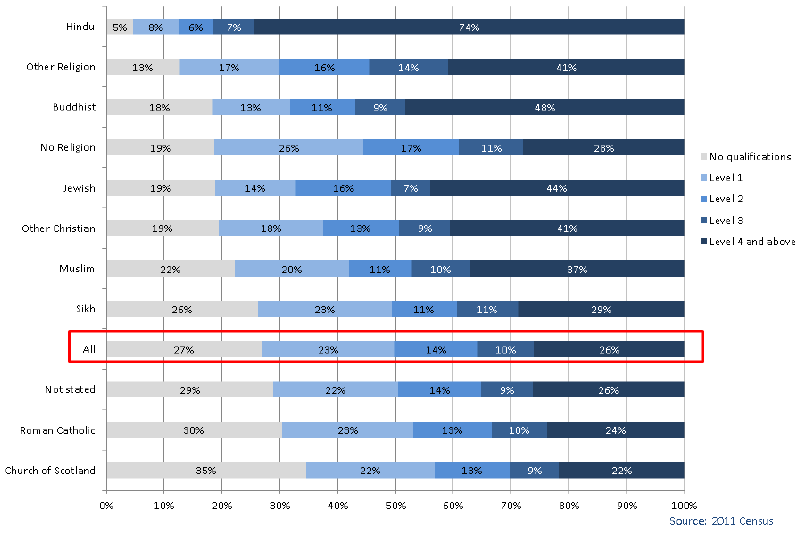
Chart 3.12 shows that around a quarter (27 per cent) of people aged 16+ had no qualifications. Around a quarter had 'Level 1' [61] , a further quarter had either 'Level 2' or 'Level 3', and the remaining quarter had 'Level 4 and above'.
Those who recorded their religion as 'Church of Scotland' were the most likely to have no qualifications (35 per cent) and those who recorded as 'Hindu' were the least likely (5 per cent).
Hindus were the most likely to be highly qualified with (74 per cent having 'Level 4 and above' qualifications), while those who recorded as 'Church of Scotland' were the least likely (22 per cent).
Key Findings:
- Those identifying as 'Church of Scotland' and 'Sikh' were most likely to own their own home and they tended to live in houses. Hindus were the least likely to own their home and tended to live in flats;
- Home ownership increased over the decade for those who recorded as 'Church of Scotland' but fell for almost every other religion;
- Roman Catholics were most likely to live in social rented accommodation;
- Hindus who rented their accommodation were most likely to rent privately and those who identified as 'Church of Scotland' and 'Roman Catholic' were most likely to live in social rented accommodation;
- Overcrowding was highest for Muslims and lowest for those who identified as 'Church of Scotland'.
Chart 3.13: Religion by Tenure - people in households aged 16+, Scotland 2011
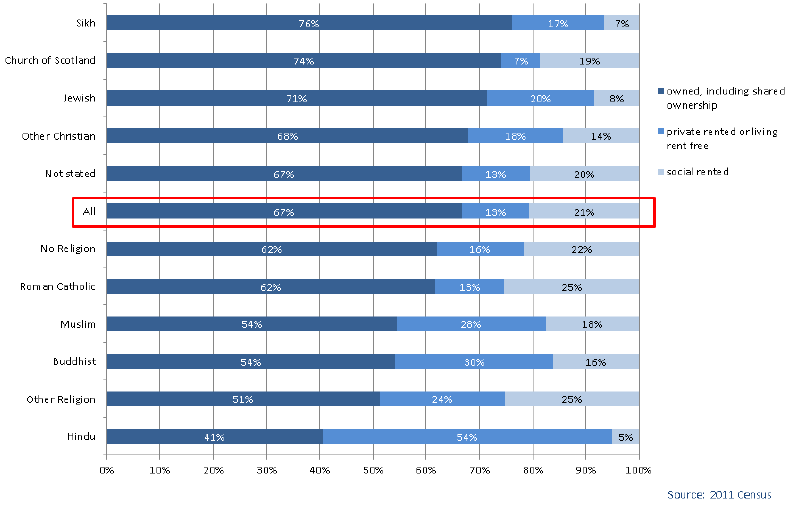
Chart 3.13 shows that two thirds (67 per cent) of people aged 16 and over owned their home (either, owned outright or with a mortgage or loan), a fifth (21 per cent) social rented and the remaining eighth (13 per cent) private rented or lived rent free. [62]
Housing tenure varied by religion group. Home ownership was high amongst those who recorded their religion as 'Church of Scotland' (74 per cent). It should be noted that this group had an older age profile.
Muslims, Buddhists and Hindus were among the least likely to own their own home. The majority of Hindus (54 per cent) privately rented or lived rent free.
Roman Catholics were most likely to social rent (25 per cent).
Chart 3.14: Home Ownership by Religion - people in households aged 16+, Scotland 2001 and 2011
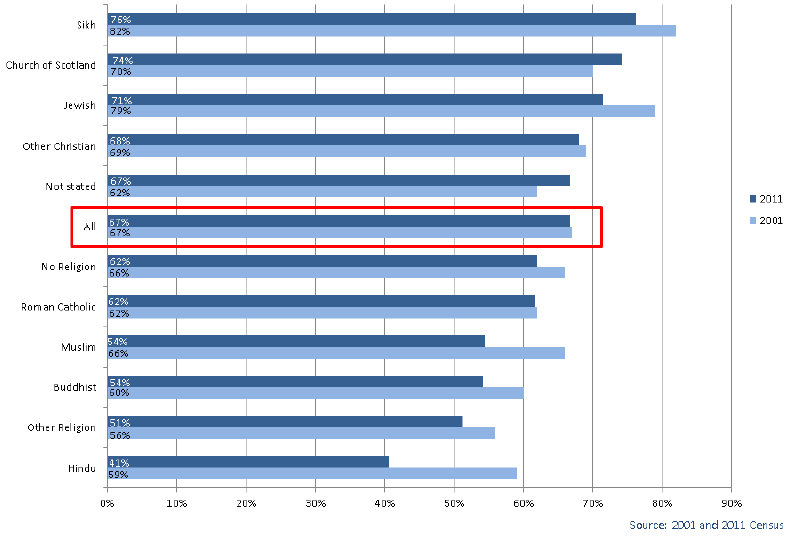
Chart 3.14 shows that home ownership remained constant between 2001 and 2011 (at 67 per cent) [63] . It increased over the decade for those who recorded as 'Church of Scotland' but fell for almost every other group. Home ownership for the 'Hindu' group fell by 18 percentage points and for the 'Muslim' group there was a 12 percentage point fall.
Chart 3.15: Religion by Type of Accommodation - all people in households, Scotland 2011
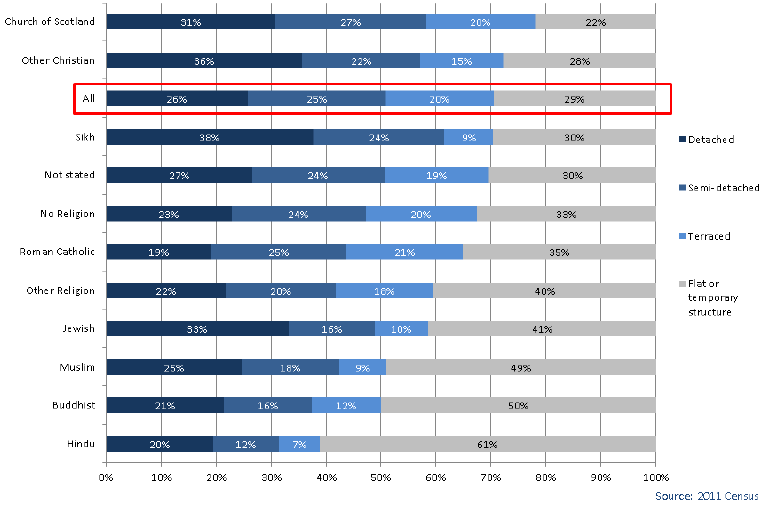
Chart 3.15 shows that over two thirds (71 per cent) of people lived in houses and just under a third (29 per cent) lived in flats. A quarter (26 per cent) of people lived in a detached house, a further quarter (25 per cent) in a semi-detached house and a fifth (20 per cent) lived in a terraced house.
Those who recorded as 'Church of Scotland' were most likely to live in a house (78 per cent) and those from the 'Sikh' group were the most likely to live in a detached house (38 per cent).
Hindus were the most likely to live in a flat (61 per cent). [64]
Chart 3.16: Religion by Landlord - people aged 16 or over in Rented Accommodation households, Scotland 2011
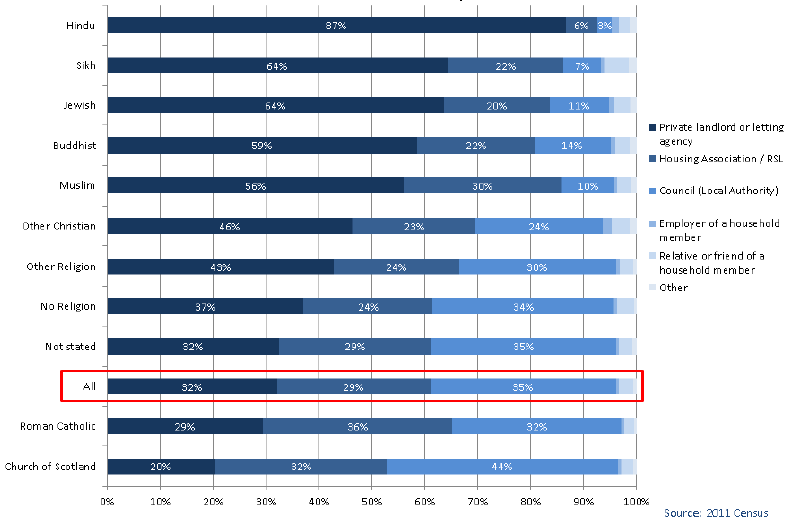
Chart 3.16 shows a fairly even split for those who rented their accommodation across the three main landlords - private, housing association/registered social landlord and council. [65]
People who recorded their religion as 'Church of Scotland' and 'Roman Catholic' were more likely to social rent than those from the other religions.
Those who identified as 'Muslim', 'Buddhist', 'Jewish', 'Sikh' and 'Hindu' were much more likely to rent privately. Almost 90 per cent of Hindus who rented their home did so through a private landlord.
Chart 3.17: Religion of Household Reference Person by Occupancy Rating, Scotland 2011
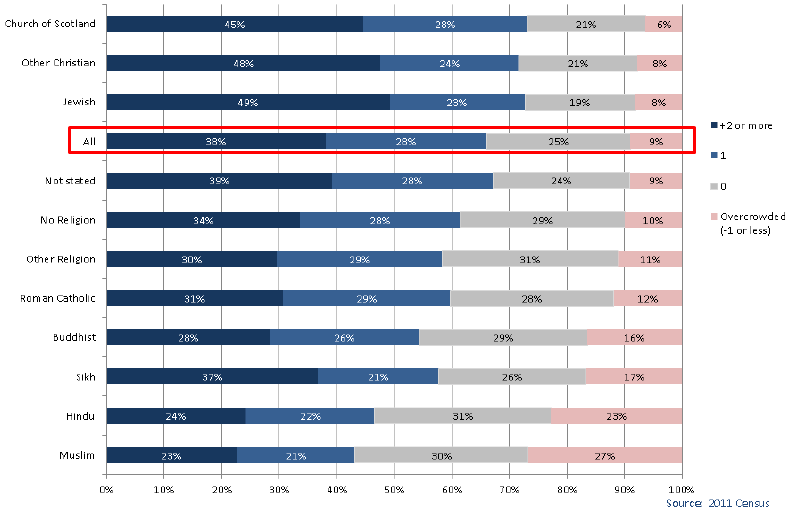
Occupancy rating [66] provides a measure of whether a household's accommodation is overcrowded or under-occupied and gives an indication of how many households may be living in overcrowded conditions. The occupancy rating of a household is calculated by subtracting the notional number of rooms required from the actual number of rooms.
Chart 3.17 shows that almost a tenth (9 per cent) of households in Scotland were overcrowded. This ranged from 6 per cent of 'Church of Scotland' households to 27 per cent of 'Muslim' households.
Three quarters (73 per cent) of 'Church of Scotland' households were under-occupied ( i.e. had more rooms than the standard requirement) compared to 60 per cent of 'Roman Catholic' and 43 per cent of 'Muslim' households.
Chart 3.18: Religion of Household Reference Person by Central Heating, Scotland 2011
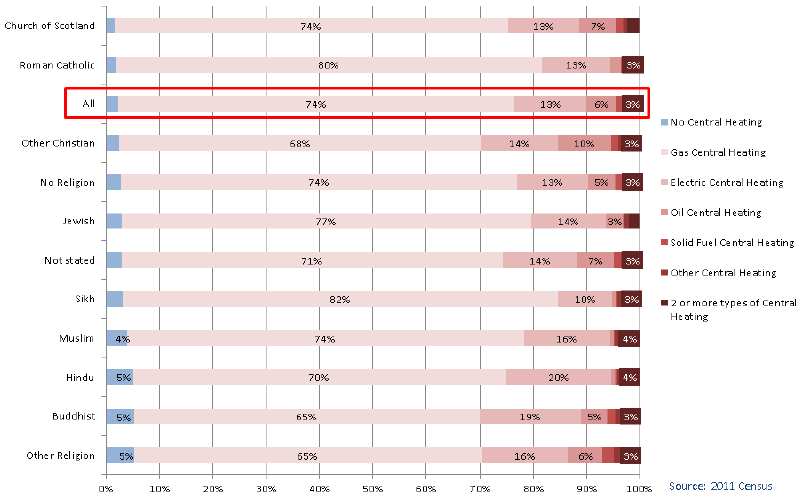
Chart 3.18 shows that the most common form of central heating in households in Scotland was gas central heating (74 per cent). Around an eighth (13 per cent) of households had electric central heating and a tenth had other types of central heating. Two per cent of households had no central heating.
'Sikh', 'Muslim', 'Hindu' and 'Buddhist' households were amongst the groups most likely to have no central heating. Households where the reference person recorded as 'Church of Scotland' were the least likely to have no central heating. Five per cent of 'Buddhist' households had no central heating.
Key Finding:
- Sikhs had the most access to a car or van and Hindus had the least.
Chart 3.19: Religion by Number of Cars - all people in Households aged 16+, Scotland 2011
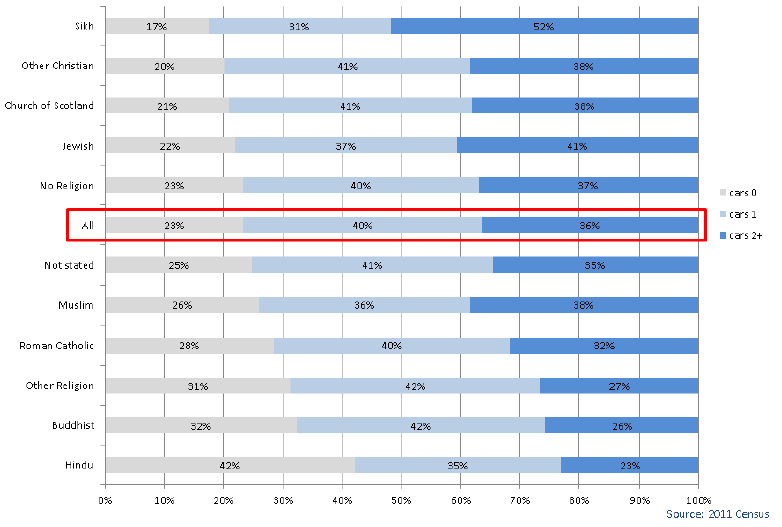
Chart 3.19 shows that around a quarter (23 per cent) of people aged 16 and over in households had no access to a car or van, two fifths (40 per cent) had access to one car or van and the remaining third (36 per cent) had access to two or more cars or vans.
Sikhs had the highest car access with the majority (52 per cent) having access to two or more cars or vans. Hindus had the lowest car access, with over two fifths (42 per cent) living in households with no access to a car or van.
People who recorded as 'Church of Scotland' had more access to cars or vans than those who recorded as 'Roman Catholic' and 'No religion'.
Chart 3.20: Religion by Number of Cars - all people aged 16+ in households in rural areas, Scotland 2011
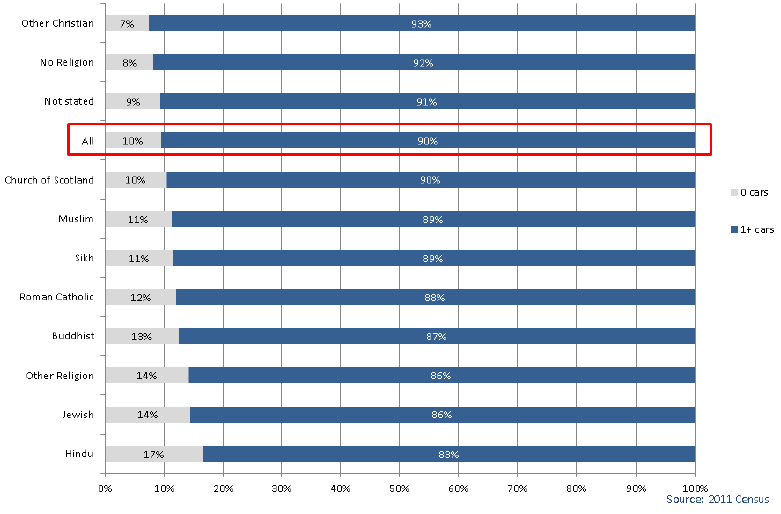
Chart 3.20 shows that a tenth (10 per cent) of people aged 16 and over in households in rural areas didn't have access to a car or van. This varied from 7 per cent of those who recorded as 'Other Christian' to 17 per cent of those who recorded as 'Hindu'. Those who recorded as 'Roman Catholic' in rural areas were more likely to have no car or van access than 'Church of Scotland' and those who recorded 'No Religion'.
Chart 3.21: Religion by Method of Travel to Work - those aged 16-74 in Employment (excluding Full-Time students), Scotland 2011
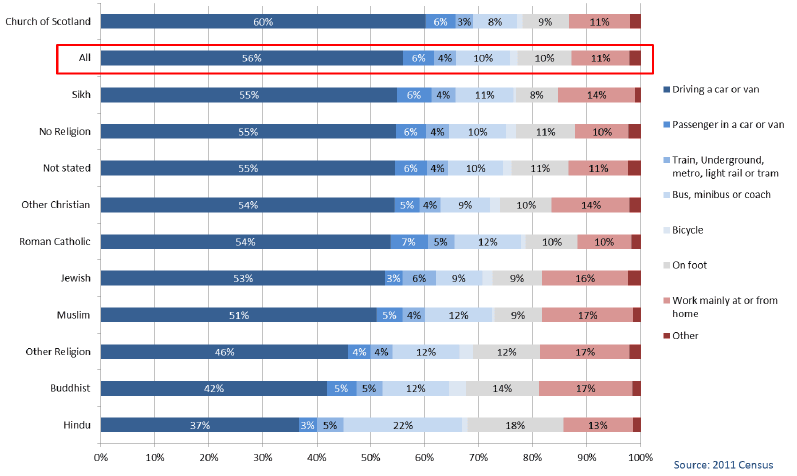
Chart 3.21 shows that the majority of people in employment drove to work (56 per cent). All of the other modes of transport were much less common with only a tenth using the bus and a tenth walking. A further tenth worked mainly at or from home.
Only those who recorded as 'Church of Scotland' had a higher than average proportion of people who drove to work (60 per cent). Hindus were the least likely to drive to work (37 per cent).
Hindus were also the group most likely to take the bus to work (22 per cent). Buddhists were the group most likely to work mainly at or from home (17 per cent).
Chart 3.22: Religion by Method of Travel to Study - all people aged 4+ studying the week before the census, Scotland 2011
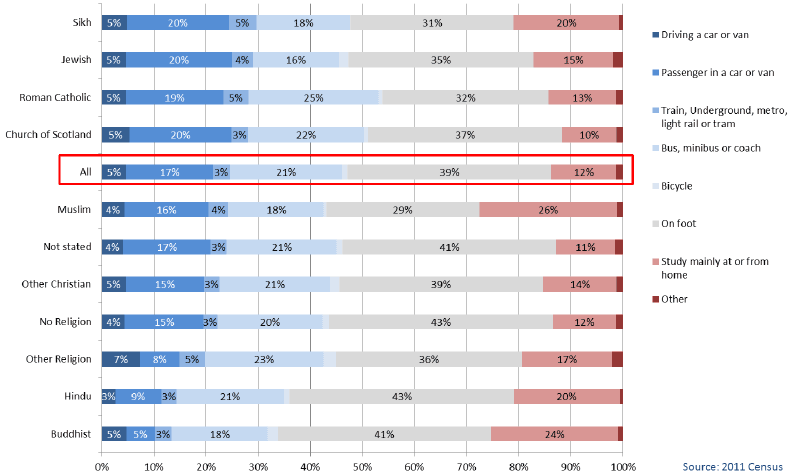
Chart 3.22 shows that the most common method of travel to study [67] was on foot (39 per cent). A fifth (21 per cent) of people travelled to their place of study by car (mainly as passengers) and a further fifth travelled by bus. An eighth of people studied at home. [68]
The 'Church of Scotland' and 'Roman Catholic' groups showed similar profiles with around half of people travelling to their place of study by car, train or bus. Those recording 'No Religion' were more likely to walk.
Those who identified as 'Sikh' and 'Jewish' were the most likely to travel by car and 'Hindu' and 'Buddhist' the least.
Chart 3.23: Religion by Distance Travelled to Work - all people aged 16-74 in Employment (excluding Full-Time students), Scotland 2011
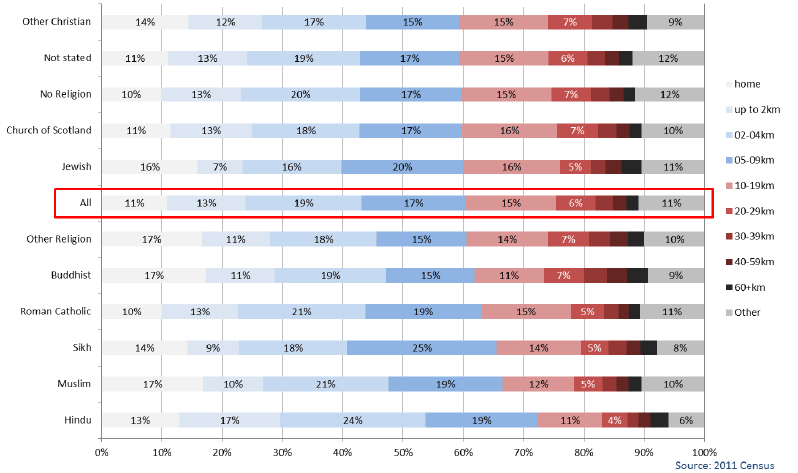
Chart 3.23 shows that the majority (60 per cent) of people travelled less than 10km to their place of work, including those who worked at home. A quarter of people travelled between 10km and 29km and 7 per cent travelled 30km or more.
Hindus were the most likely to travel shorter distances of less than 10km (72 per cent) and those who recorded as 'Other Christian' were more likely to travel longer distances of 10km or over.
Buddhists were the most likely to work mainly at or from home, and were also the most likely to travel very long distances of 30km or more.
Chart 3.24: Religion by Distance Travelled to Place of Study - all people aged 4+ Studying the week before the census, Scotland 2011
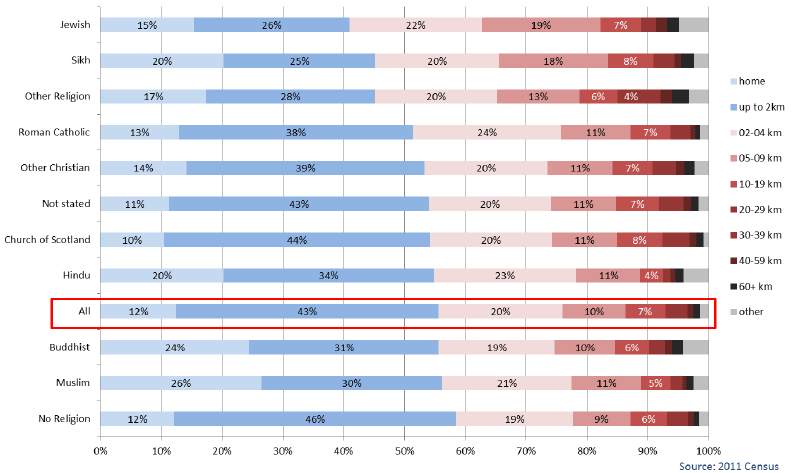
Chart 3.24 shows that the majority (56 per cent) of people who were studying travelled less than 2km to their place of study [69] , including those who studied from home. [70] A further third travelled between 2km and 9km and the remaining 12 per cent travelled 10km or more.
Those who recorded their religion as 'Jewish' were the most likely to travel longer distances of 2km or more to their place of study and those who recorded 'No religion' were the most likely to travel less than 2km.
Those who recorded an 'Other Religion' were most likely to travel very long distances of 10km or more.
Contact
Email: Poppy Wilson
Phone: 0300 244 4000 – Central Enquiry Unit
The Scottish Government
St Andrew's House
Regent Road
Edinburgh
EH1 3DG
There is a problem
Thanks for your feedback